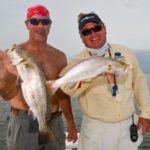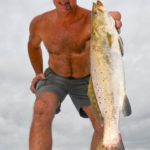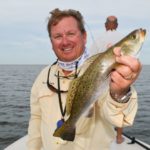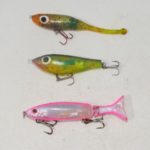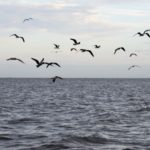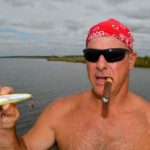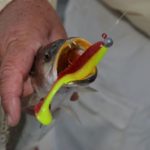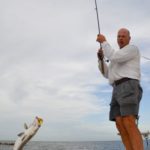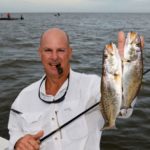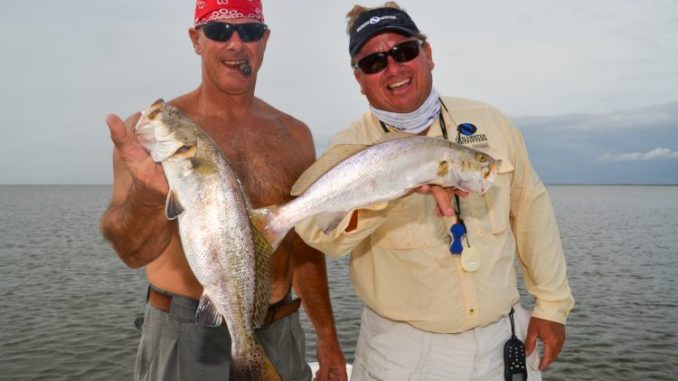
Vermilion Bay isn’t a year-round trout fishery, so many anglers ignore the area. That’s a big mistake, these trout experts say. Discover how they make the most of this fishery, which should be turned on by now.
Those wiggly, slimy, little silver fish just do something to a person.
Speckled trout might not fight as hard and be as colorful as their redfish cousins, they might not grow as large as their black drum kin and they might not be as tasty as their croaker and channel mullet relatives, but specks rule in Louisiana.
The state has lots of speckled trout fishing hotspots and every one of them has its boosters, but without a doubt the least known is the Vermilion Bay complex — the piece of coast from 4-mile Cut near Intracoastal City in the west to Burns Point in the east, the Intracoastal Waterway in the north, out to Nickel Reef in the east, Tiger Shoals in the south and Cheniere au Tigre in the west.
The place is an enigma. For six to seven months of the year, it is better habitat for freshwater catfish than for speckled trout.
Then for five to six months a year, it produces limits — with lunkers big enough to win the summer-long CCA STAR tournament.
Listen to how my two experts describe it.
“It’s a better-than-average, underutilized fishery,” Steve Smith said. “I like the area because it has a lot of oyster reefs and the opportunity to catch big fish.
“And we catch our share of big ones.”
David Billeaud agreed.
“The trout fishery here is like a wild roller coaster ride,” Billeaud said. “It’s close to where I live and, best of all, the trout fishing can be spectacular.”
Billeaud and Smith were featured master anglers in the two “Trout Masters” books published by this magazine, so both men know their subject thoroughly.
Billeaud made his first trout trip when he was 10 years old, but his family was more of a freshwater fishing family back then. He didn’t start fishing Vermilion trout until after college in the early 1980s.
But since then he has won fully rigged STAR boats twice — and he would have won a third one except for rules disallowing wins in successive years.
Nowadays he fishes for speckled trout two days a week.
Like Billeaud, Smith began fishing in freshwater. He turned to saltwater fishing in the 1990s, through his brother-n-law P.J. Naomi.
By 2009, he was a full-time fishing guide (Stillwater Outfitters, 337-654-3880), and he now spends 200 days each year on the water.
Since writing about them individually and fishing with them many times, I wanted to get them in a boat together to pick their minds. So, after a spectacular seafood meal (See this month’s Louisiana Seafood Bible column) they cooked at Smith’s Cypremort Point camp, I did just that.
The men agreed on many points of fishing the Vermilion area for speckled trout. But surprisingly often their views diverged.
Listen to what our two Trout Masters have to say.
When to fish Vermilion
There was a lot of agreement here.
“Our fishery depends on the Atchafalaya (River),” said Billeaud.
Smith agreed.
“The Atchafalaya River discharges totally control it,” he said. “When the river is below 10 feet at Butte La Rose, it allows salinity to rise in the bay. In a normal year, that takes place between the end of July and the beginning of September.
“I call it a 100-day fishery.”
They also agreed that wind could overcome a high river.
“This past year we had a lot of west wind in the summer and the bay was salty as heck, even though the river was a 17 feet,” Billeaud said.
“That’s right,” Smith chimed. “But that’s not the usual situation.”
How long will trout be in the bay?
“Good fishing lasts until the river goes up,” Billeaud said. “By January, the river usually starts to rise and the trout fishery peters out until the river drops.”
Smith said they don’t disappear completely: You just have to adjust.
“The trout are outside in the spring,” he explained.
Billeaud said the waters outside the bay clear up first, and Smith pointed to an online resource to keep tabs.
“I watch the website Modis Today (wisc.edu/modis-today),” Smith said. “It offers daily satellite images of the Gulf.”
Billeaud said the website is an invaluable tool.
“I watch it every day,” he said. “You can see things change as the winds change.”
And you don’t have to be any kind of an expert to differentiate clean water from dirty river water.
“It’s really obvious,” Smith said. “Helen Keller could see it.”
Vermilion tactics
David Billeaud and Steve Smith use quite different trout fishing tactics.
Billeaud summed up his approach succinctly.
“Run and gun; shuck and jive; move, move, move,” he said.
The angler explained that he doesn’t run from reef to reef or spot to spot, however.
“I may move 100 times on Tete Butte (Reef),” Billeaud said. “It’s about the angle of the dangle. Putting it in human terms, if you look into the sun, you can’t see much. If you look in the other direction, you see everything.
“Trout don’t go around sniffing; they have to see something to attack it. You’ve seen a bunch of boats fishing in one spot and only one boat is catching fish: He has the angle.”
The key is moving until trout are located.
“A lot of what I do is drift an area, then drop my home-made Cajun Anchor when I find fish,” Billeaud said. “I will also drift a spot and, when I am past it, crank my big motor and make another drift.”
Amazingly, he fishes without a trolling motor.
“I don’t like running a trolling motor in 3 or 4 feet of water,” Billeaud explained. “I know (the trout) can hear it. And a trolling motor just isn’t worth the B.S. that comes with it: keeping good batteries, charging batteries, picking the motor up, putting the motor down.”
Smith’s approach is different.
“I try to take a position with the wind to my back,” he said. “That gives total bait control, better bite feel and allows longer casts.
“In a perfect world, the sun would also be behind me.”
His approach is one of stealth.
“I like to stop 50 to 100 yards away, and troll or drift into position,” Smith said. “Once in position, if it’s shallow enough, I’ll put down my Power-Pole rather than anchor with my i-Pilot. On bottoms too hard for my Power-Pole, I will use a conventional anchor.”
Contrary to Billeaud, Smith said he doesn’t find a trolling motor scares trout away — if used properly.
“I don’t think that steady trolling motor noise affects trout, but the up and down of the motor on i-Pilot might,” Smith explained. “In water deeper than 8 feet, I can’t use my Power-Pole, so I have to use my i-Pilot.
Both anglers believe trout have a good sense of hearing.
Interestingly, while Billeaud won’t use a trolling motor because of noise, his depth sounder is always on. Smith, on the other hand, believes trout can hear the constant pinging of a depth sounder, so his is used only for navigation.
Once Smith is set up, he scan-casts the area from the 3 o’clock position to the 9 o’clock position, and then moves the boat one casting length away to set up for the next series of scan casts.
No discussion of trout fishing tactics is complete without addressing fishing under diving sea gulls and pelicans, and the two strongly disagreed on bird fishing.
Billeaud does it regularly and has developed his own style.
He anchors, most often with his extra-heavy Cajun Anchor, when he gets a solid strike under birds and fishes hard to “keep them on you.”
He fishes very fast, keeping a lot of bait in the water and smashing down the barbs of his jigheads so he can simply shake the fish off the hook.
“I don’t want to mess around unhooking each fish,” Billeaud growled. “It’s hard to keep the fish on you with just one fisherman in the boat, but I usually have several on board with me.
“The only time my jighead barbs aren’t smashed down is when I am fishing for big fish in the STAR Tournament. It seems like the big ones always get off.”
Smith’s views are opposite of Billeaud’s.
“I hate to fish under birds,” Smith said. “Fishing bird trout is my last choice of fishing styles. It’s like getting a root canal.
It’s hard to keep up with them. A lot of people I bring fishing can’t cast far enough to reach them, plus you have to put up with all the other sport boats coming from every direction.”
There are times when that’s his best option to put clients on fish, however.
“When I have to fish them, my philosophy is to try to follow the birds with my trolling motor as they move,” Smith said. “The only time I bend down barbs on hooks is when I have to fish bird trout. It’s a big problem for my customers (remember he is a guide) because most of them insist on pumping their rod, allowing the fish to get off.”
What’s on the hook?
One of the challenges of fishing the Vermilion Bay complex is that using live bait isn’t a viable option unless anglers catch it themselves by cast-netting at water control structures in Vermilion Parish marshes, a time-consuming task.
It isn’t profitable for bait shops to set up live bait systems for a fishery that only exists six months a year.
Needless to say, both men exclusively fish artificial lures, and they have their own reasons for that besides the lack of availability of live bait.
Smith noted that, while fishing with artificials is more challenging, it offers a lot more activity.
On that the two anglers agreed.
“Live bait is too slow,” Billeaud said. “I’m trying to keep a bite going. Why do I want to slow down to catch and put live bait on a hook?
“Plus I’m not fishing for sharks: Live bait attracts trash fish.”
Both men fish with a variety of artificial lures, including jerk baits and topwater plugs, but soft plastics on jigheads — either under a cork or tight-lined — are their bread-and-butter.
And they agreed there is more to jigs than meets a casual eye.
Most fishermen intuitively understand that a heavier jighead will make a lure sink faster and fish deeper than will a lighter one. But Billeaud pointed out that altering the size of the plastic used on the jighead will change the lure’s specific “buoyancy,” as he called it.
This, in turn, changes the way the lure fishes — not just how deep it fishes. Queen-sized plastics are the largest he uses, and bull minnows are the smallest.
Billeaud’s preference is for cocahoe-style plastics that resemble a swimming minnow; he using very few straight-tail sand eel or split-tail beetle-type tails.
He is absolutely convinced that some lure makers use better quality plastic than others. His personal favorites made by Deadly Dudley and H&H.
Favored colors include glow with chartreuse tail, LSU, 88, opening night and blue moon.
“Color isn’t always everything,” Billeuad admitted. “Some days they eat anything. I’m convinced that the best color is what they are hitting on.”
He described the 88 color as a charteruse-bellied/purple, queen-sized paddle-tail grub.
“Academy in Lafayette was trying to get rid of them because they weren’t selling and marked them down to 88 cents a pack,” Billeaud said. “Both Steve and I bought a ton of them. They’re really kind of ugly.”
Smith said those 88 lures were popularized in “Trout Masters Too.”
“And they are now well-known here,” he said. “The queen size is still the best. Big fish prefer them, and little fish don’t mind them.”
Having options when on the water, however, is important.
“Versatility is the key to the popularity of jigs,” Smith said. “Different sizes allow different presentations. If I am over an oyster bed in 2 or 3 feet of water, I will fish with a 1/8-ounce jighead. It gives me a good presentation and, at the same time, minimizes hanging up.
“If I fish in a spot with a ripping current, I use a heavier jig.”
Smith’s preferences plastic tails made by H&H, Egret and Norton. He always throws queen sizes.
He admitted he still throws the 88 color 40 percent of the time, but other favorites include chicken on a chain and clear sparkle, which he uses on clear, sunny days and in clear water.
Of course, both big-trout experts fish more than soft plastic-tipped jigs.
Topwater lures are a favorite.
“I’ll throw topwaters when water surface temperatures are 55 degrees or above all year long,” Smith said. “I would rather catch one on a topwater than five on a jig, so if it isn’t real rough and I see bait busting the surface, I will throw topwaters.”
His favorites are Rapala Skitter Walks in speckled trout color, bone-colored MirrOlure She Dogs, and “every once in a while,” a chrome-colored She Dog.
Billeaud also fishes topwater lures year-round whenever it’s calm.
“I prefer early morning, but will throw them all day long,” he said. “I want the water to be slick calm — not a ripple on it.
“One thing about topwaters: They either want it or they don’t — nothing in between.”
His favorites are MirrOlure She Dogs and Top Dogs, along with Heddon Zara Super Spooks.
He has no go-to color for topwaters.
“I think the splash is more important (than color),” Billeaud said.
They also fish with jerk baits, plugs with neutral buoyancy that allows them to be fished mid-water.
“I love my (MirrOlure) Catch 2000s and MirrOdines,” Billeaud said. “Under slick conditions — the same as for topwaters — I will go to jerk baits.
“I like to work them over submerged reefs like Tete Butte or Nickel on a high tide. I prefer the most-colorful jerk baits made: reds, blues and yellows.”
Smith has a more ordered routine for jerk bait use.
“I like to start early in the morning with topwaters, shift to jerk baits as the sun rises, and then later move to jigs on the bottom,” he explained.
His favorites include MirrOlure MirrOdines, Paul Brown twitch baits and Soft-Dine, and Egret Kick A Mullets. Pink is a favored color.
The mistakes people make
The Vermilion Bay Complex looks big on paper, and it is — but when the speckled trout bite is on, Billeaud and Smith see a lot of boats on the water.
Along with the boats, come the boo-boos.
Each trout master shared three of the biggest mistakes they commonly see other people make.
Billeaud started his short list with noise: People make too much noise.
They motor up to the spot they want to fish, throw over the anchor, put the motor in reverse to set the anchor, and then they start fishing.
Smith had to add his 2 cents on this one, which would also have made his list if Billeaud hadn’t scooped him.
“They put the anchor out with what I call the ‘Cypremort Point shot put,” he said.
Second on Billeaud’s list goes back to his belief about trolling motors.
“The second mistake is not anchoring when they find fish,” he explained. “Get off the trolling motor. Once you are on fish, any movement you make will take you off of them.”
Finally, his favorite.
“Don’t dawdle; fish fast,” Billeaud said. “People will catch a fish, stop, look at it, handle it, admire it, put it in the box and then wash their hands. It takes them five minutes to get their bait back in the water. It’s like feeding fish in an aquarium. You stop feeding them; they stop coming. That’s why I don’t like fishing with only two people in the boat. I want baits in the water.
“A while back, we were on anchor and a boat came up and anchored 100 yards from us. Their wake hadn’t settled before they started catching fish. They were on them, but they weren’t keeping their baits in the water. They were more worried about admiring their fish and washing their hands.
“I predicted that we would steal their fish. Thirty-five minutes later, we had our 75 trout; they stopped catching. When we left, I waved them over to our spot.”
Smith started his list with his pet peeve.
“Anglers don’t commonly look for fish: They look for boats,” he said. “Cypremort Point may be the worst for this because it’s so open. They see boats, and then they hem up next to the ones that are catching fish and aggravate the snot out of them.”
The second mistake, Smith said, is that anglers don’t know when to move. Some fishermen pull up to a spot, make two casts and leave. Others homestead a spot, apparently believing fish will come to them.
“Thirty minutes in a spot is about right for me,” he said.
Billeaud grunted.
“That’s too long for me,” he said. “Fifteen to 20 minutes and I am ready to move.”
Smith wrapped up with the assertion that most anglers aren’t observant enough.
“The last thing is that people don’t keep their eyes open,” he said. “They just don’t look around them. If I see a slick anywhere, I stop — even in the middle of the bay.
“Watch the horizon constantly for pelican and sea gull activity. Watch for fish busting the surface of the water. Above all, look for the presence of bait, schools of pogies flicking the surface, shrimp popping, and mullets jumping.”
